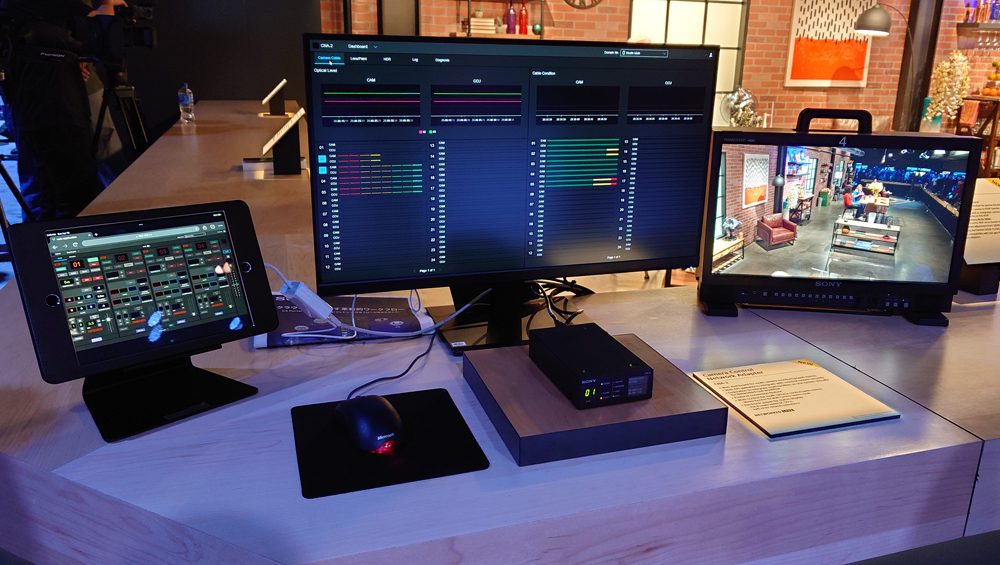
Broadcasters Put New Demands On Their Cameras

Camera companies are tightening their focus on integration into broadcast workflows even as they sharpen the capabilities of their offerings.
As broadcasters seek IP-ready equipment, vendors are answering the call with new cameras. At the same time, broadcasters want standards flexibility baked into cameras, easier control of multicamera environments and better visuals. They also want camcorders in the field to be able perform more of the functions of a traditional studio camera set up. And as studios seek to improve the safety of their operations, some are looking toward wireless roving cameras.
Rob Willox, Sony’s director of product marketing for media solutions, said IP has become a huge factor, particularly in how Sony products integrate with those from other vendors.
“It’s like the beginning of digital again,” he says. The rule Sony follows is “Thou shalt do no harm, but it takes a lot of consulting” to ensure all the pieces work together.
Earlier this year, JVC introduced its first NDI-compatible broadcast cameras for IP environments. Craig Yanagi, national product manager for the professional video division at JVCKenwood USA Corp, says local news markets have been asking for NDI, HX (high efficiency) products.
“With NDI, HX capability, the camera can be discovered instantaneously within the NDI HX LAN. It’s extremely easy implementation into that infrastructure,” he says.
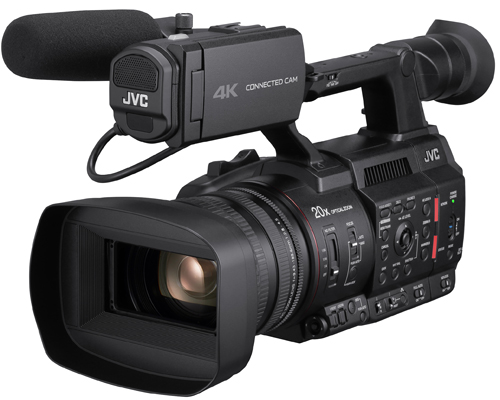
JVC’s GY-HC500UN camera
The broadcast version of the new HC500 series, the GY-HC550UN, has graphics generation capability, Yanagi says, and can add watermarking, lower thirds, station logos and network logos onto the streamed video.
“What we brought to NAB is everything that the marketplace has asked for” when it comes to providing broadcast-quality solutions from image capture to distribution, he says. “It’s a glass-to-glass solution that’s based on NDI, HX.”
Panasonic just started shipping its AW-UE160 PTZ camera, which has a 2110 option. “We’re finding a trend of [broadcasters] using PTZs more in studio as well as for remote interviews,” Jim Jensen, senior category owner for PTZ and remote production at Panasonic, says.
He says the AW-UE160 is a high-end PTZ with improved picture quality and features that “match those of lower lower-price studio cameras.”
It also has a built-in optical low-pass filter to help mitigate the moire effect from shooting video against LED wall backdrops, he says. It also has large tally lights in front and in back of the camera.
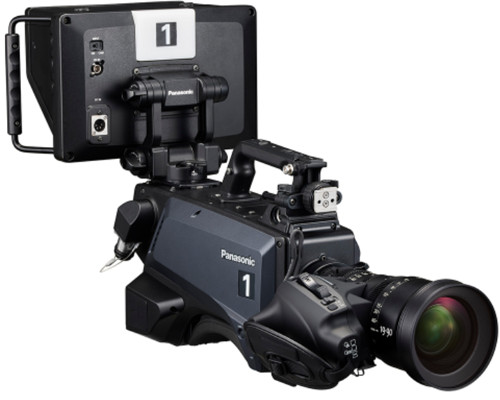
Panasonic’s AK-PLV100 camera
The new PTZ also includes workflow capabilities that broadcasters want in studio cameras, he adds.
Mike Bergeron, senior category owner of advanced technology and video production for Panasonic, says the company’s new AK-PLV100 camera also supports a 2110 connection direct to the camera head. The AK-PLV100 supports a cinema workflow with vlog recording, but the rest of the camera’s connectivity is based on the studio camera frame, with a studio camera chassis and fiber connectivity for return video, intercom, tally, control and teleprompter.
“If you look at it from the back, it looks like a studio camera, and if you look at it from the front, it has the 35 glass,” he says.
Announced during the NAB New York show, the new camera has shipped to a rental company and to the film school at New York University, he says.
Kenneth Cyr, national sales manager for Hitachi Kokusai, says one of the chief things broadcasters are asking for with field production cameras is flexibility.
“The way broadcasters are being so creative, they need the flexibility,” he says. “Nobody wants to be locked into standards anymore.”
They want the ability to work in any format they prefer, such as shooting in HDR but with the capability to paint the SDR feed, he says, but cameras have traditionally locked users into specific formats.
“Everything that we’d traditionally have one camera do for a customer, they’d have to look at this model or that model,” Cyr says.
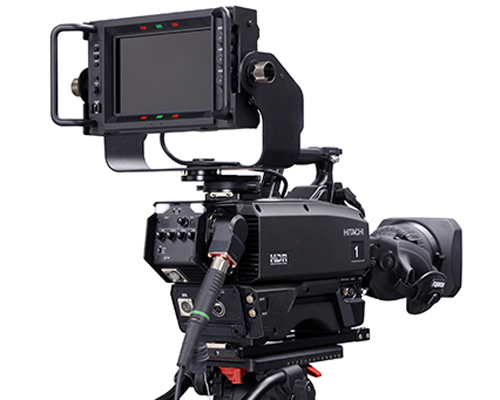
Hitachi’s Z-HD6500 camera
Hitachi’s new cameras, such as the new Z-HD6500 camera which supports multiple HD formats to 1080p, feature technology to improve processing power cameras to provide that flexibility, he says.
“The power of the processors in the cameras give us the ability to do that,” he says. “You can design or do whatever you want with any of the Hitachi cameras.”
Broadcasters are also using more cameras than ever to capture the shots they want.
Sony showed off its CAN-2 camera control network adapter for multi-camera projects at this year’s NAB Show in Las Vegas.
“It allows us to look at up to 288 cameras over three different networks,” Willox says.
Josh Stoner, senior product specialist for broadcast and cinema lenses at Canon, says the company’s Cine-Servo 15-120mm 8K lens provides a cinematic look, or shallow depth of field shots, that sports coverage has increasingly used.
Whether the 8K lens is used with an 8K camera or a high-end 4K camera, the user gets “a clean image,” he says. Those images are also useful for extraction and slow motion in sporting events. During the Super Bowl, Sony’s Cine-Servo 15-120mm was set up to provide super slow motion and extraction for replays “without sacrificing any resolution,” he says.
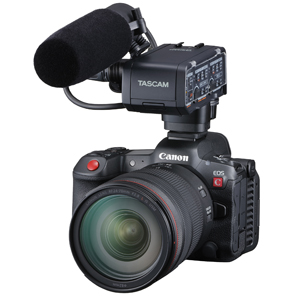
Canon’s R5 C camera
Ryan Snyder, senior technical specialist for cinema cameras and lenses at Canon, says the company’s EOS R5 C camera, which can record non-stop 4K and 8K, will get a power-saving mode capability around June.
“It uses the same batteries that the mirrorless camera does. We’re putting a power-saving mode in for shooting in 4K, and they can expect a 30% increase in battery life with that,” he says.
The update will also improve the user interface when the EOS R5 C camera is combined with dual fish-eye lenses. The improved interface will magnify the image when shooting in 8K to check for critical focus and offer the ability to change between the two lenses, he says.
Canon’s fish-eye lenses and R5 C are being combined for virtual reality content. Canon worked with Media Monks, an early VR adopter, to create a live workflow, Snyder says. The footage is recorded and brought into Canon’s VR utility or plugged into Adobe Premier, where the two images are stitched together.
“With 8K resolution, you’re getting 4K resolution per eye. That’s a lot of resolution, a lot of data to process,” he says. “It takes a lot of processing power to do that live with 8K resolution.”
Alan Bucaria, director of photography at Media Monks, says the automatic stitching of the footage through Canon’s workflow vastly simplifies the creation of VR content.
“You need to understand how to shoot virtual reality footage,” but beyond that it “doesn’t require technical aptitude,” he says.
Patrick Jones, senior director of engineering for live and broadcast and creative solutions at Media Monks, says the new VR workflow capabilities make a huge difference. “The technology has gotten so much better,” he says.
And the technology for capturing VR footage and for delivering it to users continues to improve. “We’re reaching a point where you won’t be able to tell between real life and this (headset),” Hon-Ming Gianotti, director of innovation at Media Monks, says.
In the world of camera robotics, wireless capabilities streamline maneuverability and improve safety.
Telemetrics VP Michael Cuomo says cables dragging on the floor behind rover units can be problematic, as cables can still get caught up in obstacles on the floor such as other camera cables. “They still need a person to manage the cables, even though it’s robotic.”
Telemetrics showed off its wireless OmniGlide Roving Pedestal at the NAB Show. It runs on battery power and has wireless video transmission capabilities.
While autonomous robots typically have a planned path from point A to point B and can be tripped up by an object in the way such as cables, the OmniGlide detects the object in the way and navigates around it to get to the destination.
“That’s where wireless rover comes in. We can handle the path planning and not have to worry about cable management,” Cuomo says. “It’s an add-on for our existing customer base. There’s an upgrade path for any existing rover.”
































Comments (0)